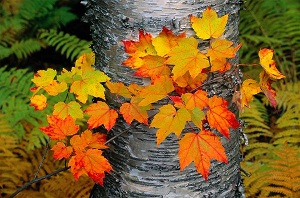Fall Leaves: "Ideal Conditions" Seen for Foliage in U.S.
 There may be one upside to the United States’ dry summer—a brilliant fall leaves season, especially in the Northeast.
There may be one upside to the United States’ dry summer—a brilliant fall leaves season, especially in the Northeast. Moderate drought can increase concentrations of anthocyanins, the natural pigments that produce the reds and purples in tree species including ash, black gum, sumac, and some maples, according to Donald J. Leopold, a dendrologist—or tree scientist—at the SUNY College of Environmental Science and Forestry in Syracuse.
“From what we’ve seen so far, the trees that have the potential for producing lots of anthocyanins look as good as they’ve ever been this year,” Leopold said.
Weather in the coming weeks, including temperatures and rainfall, will determine just how brilliant this year’s leaves will be in the Northeast and across the country.
And how long they last may depend on storms, like 2011’s Halloween surprise snowfall, which abruptly ended the fall foliage season in much of the U.S. East.
“Once the leaves get to their peak color, they can stay on a tree for maybe to five to seven days-unless there is a really strong storm with heavy rain and 50-mile-per-hour [80-kilometer-per-hour] winds,” Leopold said.
Why Leaves Change Color
Leaves begin to turn colors each year when shorter days signal the arrival of autumn. The shift prompts some trees to recoup nutrients such as nitrogen and phosphorus before they shed their leaves for the winter.
Some species also produce reddish anthocyanins in the autumn for reasons that scientists don’t entirely understand. The compounds may serve as antifreeze, sunscreen, or even insect repellent for the tree.
Natural pigments that produce yellow, orange, and brown colors, called carotenoids, are always present in leaves. They emerge only when photosynthesis stops and chlorophyll, which masks the cartenoids with green color, fades away.
Both processes are now well underway. “If anything, I think this season might peak a week or so early,” Leopold added, “because of the early start and because it has been cool at night recently. It’s really just ideal conditions for fall color in the Northeast.”
Fall Leaves Brilliant in Rockies, Too
Fall colors are also especially vibrant in other parts of the country right now, including the U.S. Rocky Mountains, Leopold noted.
Colors have “already peaked at the higher elevations, and I understand that with the dry conditions, the usually phenomenal aspen display was really good this year.”
The Midwest, on the other hand, suffered extreme drought last summer.
“They simply don’t have the foliage potential, so it’s not as noticeable. Fall colors in the Midwest tend to be rather boring,” said Leopold, who is himself a native Midwesterner.
Increasingly, people can see some of the Northeast tree species’ fall colors in other places, he added.
“We’ve really lucked out by having 20 types of trees, which are naturally occurring in the Northeast, that people plant all over the country just for fall colors.”
You can return to the main Market News page, or press the Back button on your browser.

